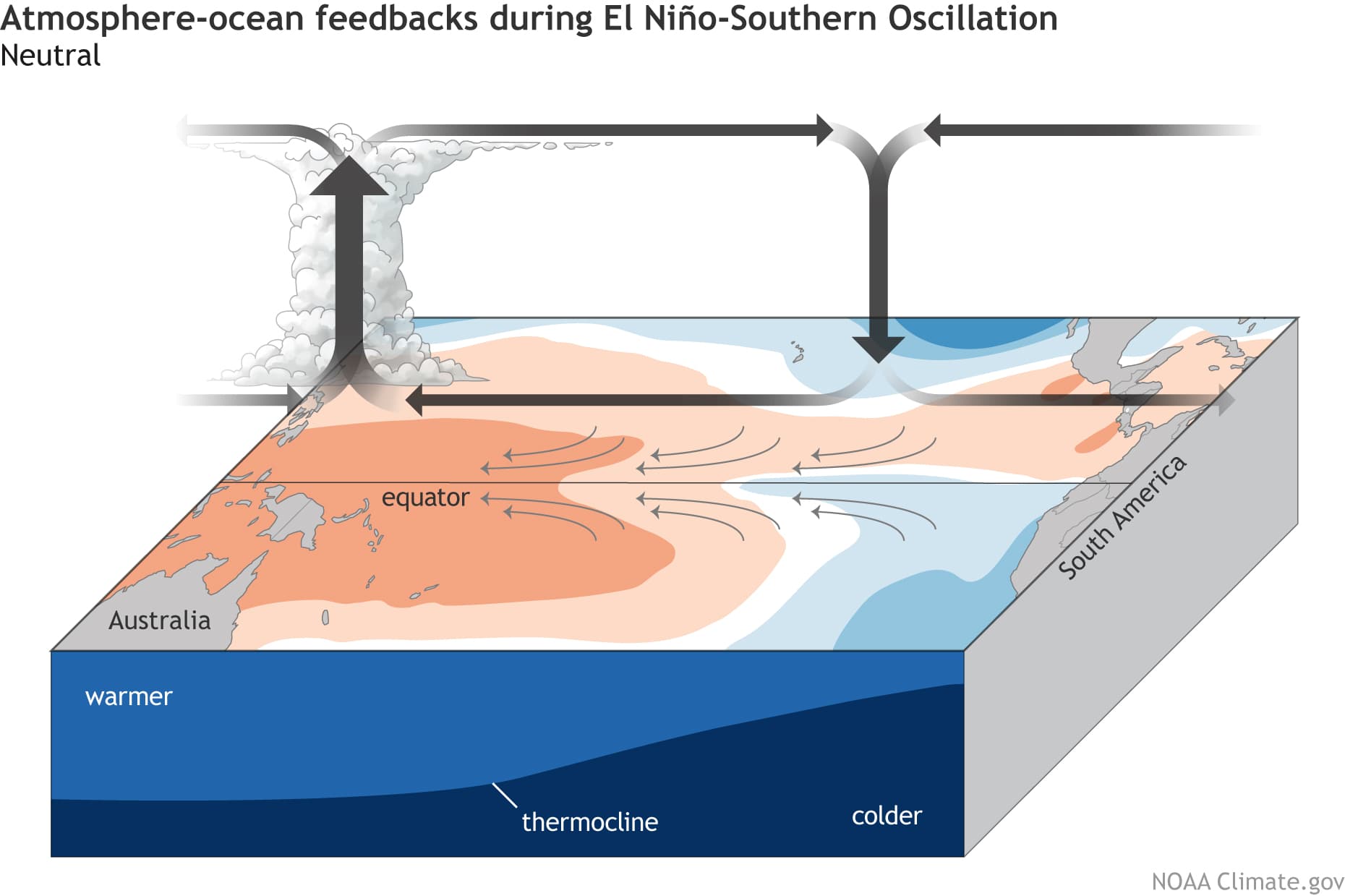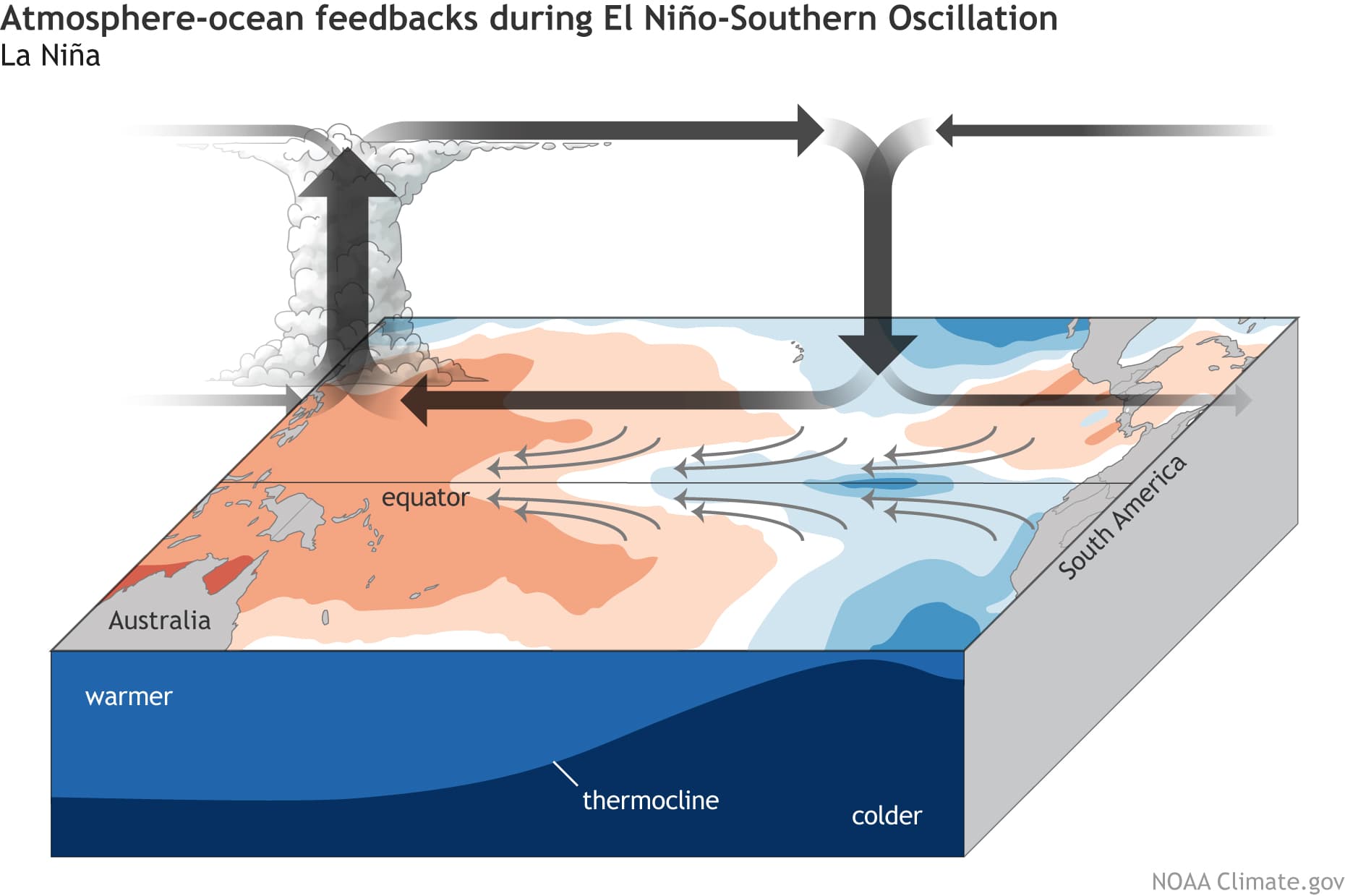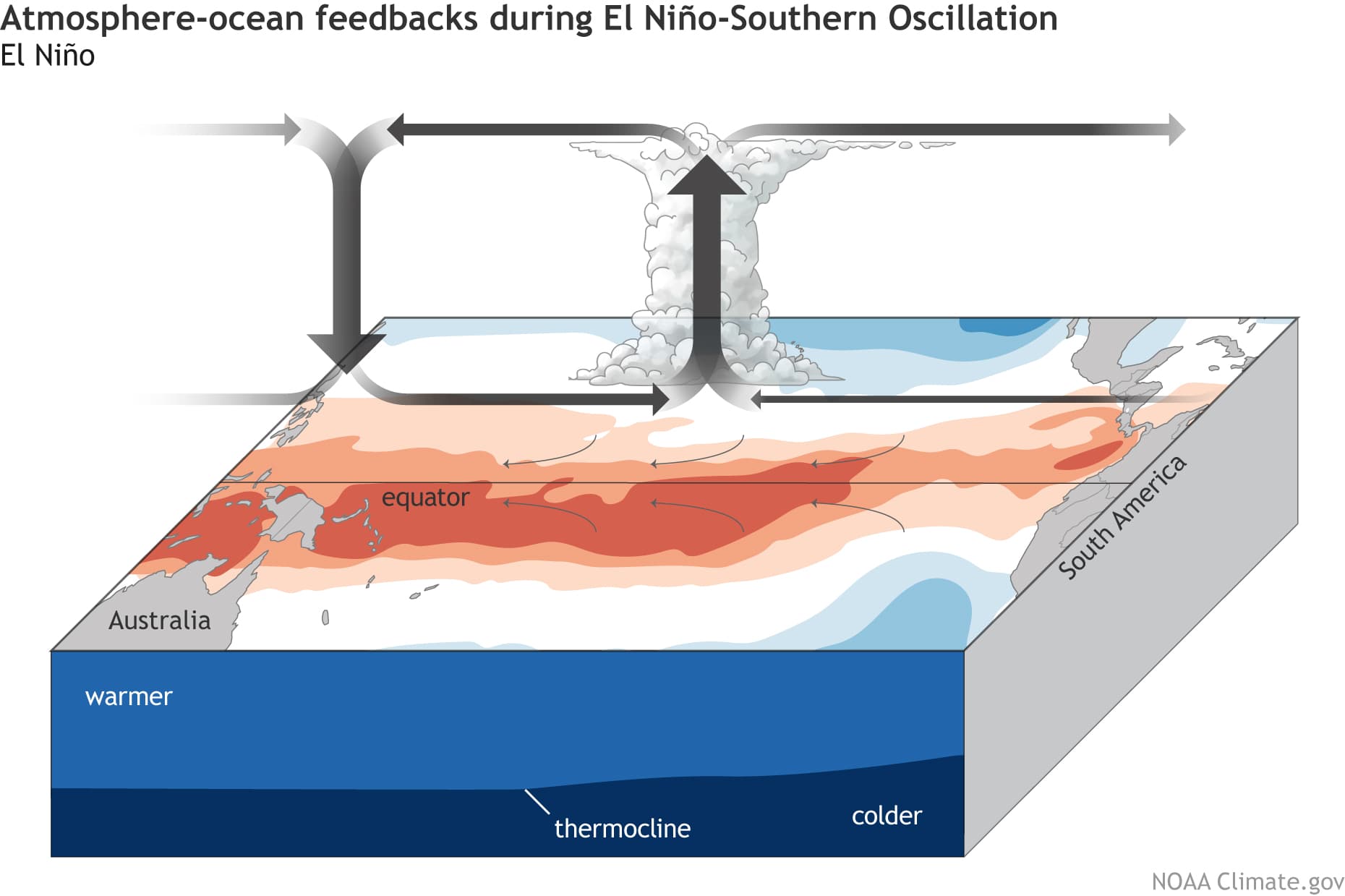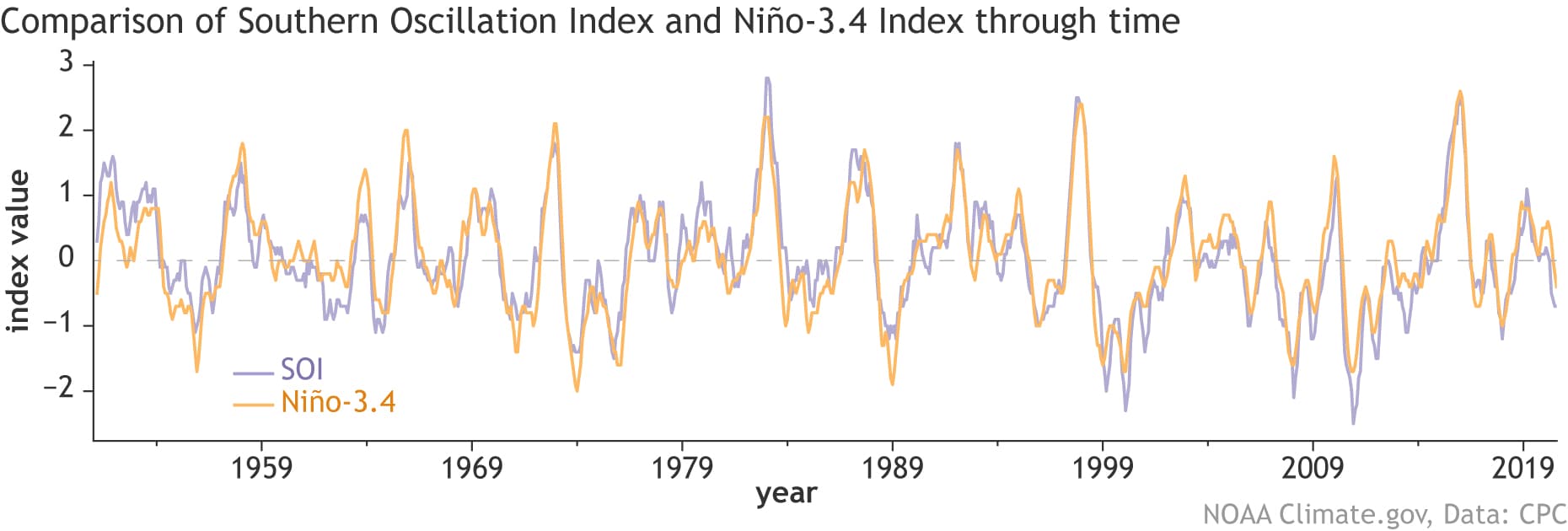
This post first appeared on the climate.gov ENSO blog and was written by Michelle L’Heureux
We often get asked how El Niño or La Niña events form and increase in strength. The key is in the ocean-atmosphere coupling across the tropical Pacific Ocean. Without it, ENSO would not exist, and it would be considerably more difficult to predict climate impacts seasons in advance. Various ingredients of the ocean have to be combined with the atmosphere in order for ENSO to blossom and grow. Flour and yeast also would be pretty boring and inert on their own, but when put together, they reinforce each other, the combined product increases in size, and eventually, it releases the heavenly scents of fresh-baked bread. That’s right, I’m basically saying ENSO is fresh-baked bread (Mmm, ENSO, you’re so tasty).
Assemble the Ingredients
But how do the ocean and atmosphere come together to make the bread ENSO? Good question and, incredibly, this problem took nearly fifty years to solve, even after all of the basic ingredients were uncovered. We have described the Walker Circulation many times before, which is named after Gilbert Walker because he is very important to the field of meteorology and climate. While working in India from 1903-23, he observed: “the swaying of [atmospheric] pressure on a big scale backward and forwards between the Pacific Ocean and the Indian Ocean” (Adamson, 2020). He called this large-scale seesaw in pressure the Southern Oscillation to draw contrast with the more northern locales of other climate phenomena he also identified and named, like the North Atlantic Oscillation (yes, the same guy!).
Unfortunately for him, at the time, Walker’s discoveries were treated more as scientific curiosities than anything else. No one really knew why the Southern Oscillation existed, and they certainly didn’t grasp the larger implications of his discovery until a guy by the name of Jacob Bjerknes had his “ah-ha!” moment in the 1960s (1). By using new satellites and observations from Canton Island in the South Pacific Ocean, Bjerknes was able to link changes in the pressure pattern that Walker discovered with fluctuations in temperature in the tropical Pacific Ocean (2). He brilliantly realized it was all one big system and that the ocean and atmosphere were “coupled,” meaning that the pressure and temperature patterns rely on interactions between the ocean and atmosphere.
As the Dough Rises
But how does this coupling allow ENSO to emerge and grow? The magic is in feedbacks and, in particular, what we now call the Bjerknes feedback.
In climate, feedbacks do not refer to comments on performance reviews or the squeak of a microphone, but rather physical processes that reinforce each other (positive feedback) or destroy each other (negative feedback). The Bjerknes feedback is positive feedback between tropical Pacific surface wind and ocean temperature, which essentially means processes in the ocean and atmosphere goad each other to bring on an ENSO event. As I write, we’re in a La Niña, so I’ll outline the feedback starting there.
During La Niña
We often don’t know exactly what initiates the feedback loop—sometimes sea surface temperatures start to cool and then the trade winds begin to strengthen, or vice versa (3). But, we have to start somewhere, so I’ll start with the ocean cooling (4). This means the difference (or gradient) in temperature between the relatively warmer western Pacific and the cooler eastern Pacific becomes even larger than normal. Over the western Pacific, warmer temperatures cause air near the surface to rise, moisten, and become convective, leading to thunderstorms and more rain (just like how warm air rises into an attic, though thankfully, thunderstorms won’t form in a house). Over the cooler eastern Pacific, air begins to sink more and dry out (also why basements are colder). With the increases in sinking motion over the eastern Pacific and rising motion over the western Pacific, the trade winds that typically blow from east-to-west along the equator become even stronger.

These stronger-than-normal winds, in turn (here’s the feedback!), then help to reinforce the ocean temperature anomalies by increasingly pushing water away from the eastern Pacific to the western Pacific Ocean. This allows deeper colder water, which is residing below the surface of the surface water, to upwell and cool the surface even more. These same winds help to transport surface water, heated by the sun along the way, to the western Pacific, which literally piles up warmer water around Indonesia (sea level height also increases). What do these warmer waters do? They help the air to rise even more over Indonesia (leading to increased convection/rainfall in the region) and, over the central and eastern Pacific Ocean, the colder surface waters result in diminished convection/rainfall (5). In summary, the initial stronger-than-normal trade winds and east-west contrast in surface temperatures become even stronger because of this positive Bjerknes feedback.
During El Niño
The feedback begins when the trade winds weaken and/or the sea surface temperatures warm in the parts of the central and eastern Pacific Ocean. Starting with changes in the ocean, this means that the normally cool eastern Pacific becomes warmer, leading to increased rising motion over the central and/or eastern Pacific and more convection and rainfall. Over Indonesia and the far western Pacific, the waters cool slightly, resulting in more sinking motion (less rainfall and convection). Meanwhile, the trade winds (that typically blow along the equator from the east-to-west) weaken because they normally blow from areas of sinking motion to areas of rising motion–now those areas are reduced relative to the normal state.

These weaker surface winds (feedback time!) then, in turn, result in the reduction of the cold-water upwelling from the deep ocean in the eastern Pacific Ocean. Because the upwelling reduces and there is less transport from the eastern to the western Pacific, the temperatures increase in the east. Now the winds are acting to reinforce the initial oceanic warming! Also, because of the slowdown in the transport of water to the western Pacific Ocean, the sea surface temperatures and sea level height sometimes decrease in the west (though maybe less so in recent years).
Fresh out of the oven
So this is how changes in the ocean temperature push along the atmospheric variations in winds/pressure/rainfall, and, vice versa, the atmospheric changes help to reinforce the ocean temperatures. However, El Niño and La Niña events don’t last forever—these events sow the seeds of their own destruction, through delayed processes in the ocean that I’ve described before.
The Bjerknes feedback also explains why there are so many different ways to measure ENSO. There are dozens of time series, or indexes, of various types (composed of temperature, pressure, rainfall, winds, etc.) that are strongly related, or as we say, correlated (a perfect correlation has a value of 1). For instance, the Southern Oscillation Index (based on sea level pressure differences) has a correlation of ~0.9 with the Niño-3.4 index (measures sea surface temperatures in the east-central equatorial Pacific Ocean). The strong links between different types of meteorological variables are evidence that ENSO is one very large and interconnected system!

So next time you smell freshly baked bread, think of Jacob Bjerknes, who wrote the recipe, assembling the ingredients of the ocean and atmosphere that give rise to the marvelous climate phenomenon we now call the El Niño-Southern Oscillation or ENSO.
excuse me sir, can i get the link from PMEI about pciture during neutral,elnino and lanina?